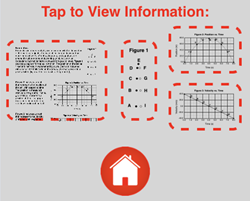Kinematics
 Highly Recommended
Highly Recommended
Like all our Science Reasoning Center activities, the completion of the Kinematics activity requires that a student use provided information about a phenomenon, experiment, or data presentation to answer questions. This information is accessible by tapping on the small thumbnails found on the bottom right of every question screen. However, it may be considerably easier to have a printed copy of this information or to display the information in a separate browser window. You can access this information from
this page.
The Standards
The Kinematics activity describes a ball tossed upward into the air. The description includes a dot diagram, a position-time graph, and a velocity-time graph. Questions target a student's ability to extract meaningful data from diagrams and graphs, to interpret graphs, and to make connections between the diagrams and graphs.
Success with the activity requires some degree of proficiency or understanding with respect to ...
- Interpretation of Data (Science and Engineering Practice 4.1)
Analyze data using tools, technologies, and/or models (e.g., computational, mathematical) in order to make valid and reliable scientific claims.
- Interpretation of Data (Science and Engineering Practice 4.4)
Compare and contrast various types of data sets to examine consistency of measurements and observations.
- Patterns (Crosscutting Concept 1.5)
Mathematical representations are needed to identify some patterns.
While the Kinematics activity addresses the two NextGen Science and Engineering Practices and one Crosscutting Concept above, the activity drew its greatest inspiration from
ACT's College Readiness Standards for Science Reasoning. The activity consists of 66 questions organized into 21 Question Groups that are spread across the five activities. All questions focus on the Interpretation of Data (IOD) strand of the College Readiness Standards. The code given for the standard includes three letters to indicate the strand (IOD) and three numbers to indicate the specific standard within that strand. Higher numbers correlate to more complex science reasoning skills. The relationship between the questions and the standards is as follows:
Complementary and Similar Resources
The following resources at The Physics Classroom website complement the Kinematics Science Reasoning Activity. Teachers may find them useful for supporting students and for crafting lesson plans and unit plans.
The Physics Classroom Tutorial: Kinematics Chapter, Lesson 5
Physics Video Tutorial, Kinematics Chapter: Free Fall Motion - The Basics
Concept Builders, 1-D Kinematics, Free Fall
Concept Builders, 1-D Kinematics, Up and Down
Calculator Pad, Kinematics, Problem Sets K19 - K22